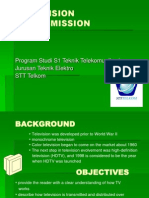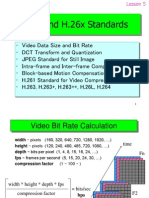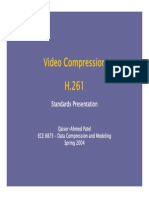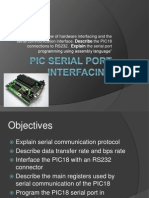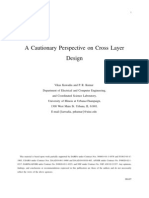DV Cam Format
DV Cam Format
Uploaded by
Laurentiu IacobCopyright:
Available Formats
DV Cam Format
DV Cam Format
Uploaded by
Laurentiu IacobOriginal Title
Copyright
Available Formats
Share this document
Did you find this document useful?
Is this content inappropriate?
Copyright:
Available Formats
DV Cam Format
DV Cam Format
Uploaded by
Laurentiu IacobCopyright:
Available Formats
THE DVCAM FORMAT
Clyde Cunningham
Copyright 2005 Clyde Cunningham
The Sony DVCAM format is based on the
International Electrotechnical Commission
DV standard
IEC 61834
This document consists of ten parts, of which only Parts 1 and 2
are related to standard definition video recording.
The remaining parts define the format for HDTV, EDTV, DVB
and DTV applications.
The only major difference between
DV and DVCAM is Track Pitch.
DV Track Pitch 10m
DVCAM Track Pitch 15m
BASIC DVCAM PARAMETERS
Track pitch 15m
Track angle 9.1752
Tape speed 28.247mm/s
Tape width 6.35mm
Drum diameter 21.7mm
Track azimuth -20/+20
Tape type Metal evaporated
Mechanical
Electrical
Bit rate to tape 41.85 Mb/s
Video bit rate 24.948 Mb/s
Minimum wavelength 0.49m
Modulation SNRZI PRIV
(24 to 25 bit)
Error correction Reed-Solomon
Cross interleaved
Tracks per TV frame 625/50 12
525/60 10
Lines recorded 625/50 23 - 310
335 - 622
525/60 23 - 262
285 - 524
Sampling structure 625/50 4:2:0
525/60 4:1:1
Compression Intra-frame DCT
Adaptive quantization
Modified 2-D Huffman
Video
Audio
2 Channel mode 16 bit linear/48kHz
4 Channel mode 12 bit non-linear/32kHz
In the DVCAM standard
the audio sampling rate
MUST be locked
to video frame rate
A DVCAM recording where the
audio sampling rate is not locked
to video frame rate is considered
to be NON-STANDARD.
This will be indicated on the front
panel of DVCAM units as
NS or Not editable
DVCAM VIDEO PROCESSING
4:2:2 Video Sampling
Analog
to
Digital
Converter
Y
13.5MHz (4)
Analog
to
Digital
Converter
Cb (B-Y)
6.75MHz (2)
Analog
to
Digital
Converter
Cr (R-Y)
6.75MHz (2)
8 bits
8 bits
8 bits
ANALOG 4:2:2 DIGITAL
4:2:2 Sampling Structure
Colour Sample Decimation
Delay
Decimation
Filter
Decimation
Filter
INPUT
4:2:2
OUTPUT
4:1:1 (525/60)
4:2:0 (625/50)
Y
Cb
Cr
Why is filtering necessary?
Why cant you just throw away
every alternate colour sample?
6.75Mhz 13.5Mhz 20.25Mhz 3.375Mhz
SAMPLED COLOUR-DIFFERENCE SPECTRUM
4:2:2
6.75Mhz 13.5Mhz 20.25Mhz 3.375Mhz
SAMPLE DECIMATION WITHOUT FILTERING
ALAISING ALAISING ALAISING ALAISING ALAISING ALAISING
10.125Mhz 16.875Mhz
4:1:1
6.75Mhz 13.5Mhz 20.25Mhz 1.6875Mhz
FILTERED COLOUR-DIFFERENCE SPECTRUM (before decimation)
4:2:2
4:1:1
FILTERED COLOUR-DIFFERENCE SPECTRUM (after decimation)
6.75Mhz 13.5Mhz 20.25Mhz 3.375Mhz 10.125Mhz 16.875Mhz
4:1:1 colour samples decimated HORIZONTALLY.
So Horizontal filtering is necessary.
4:2:0 colour samples decimated VERTICALLY.
So vertical filtering is necessary.
4:2:0 Video Sampling Structure
4:1:1 Video Sampling Structure
4:1:1 4:2:0
Colour Resolution Comparison
Effect of Sample Decimation on Colour Resolution
1.5MHz
Horizontal colour resolution
(= 120 Lines resolution)
3MHz
4:2:2
(= 240 Lines resolution)
4:1:1
200 Lines
Vertical colour resolution
400 Lines
4:2:2 4:2:0
4:1:1 Horizontal colour resolution = 120 Lines
4:1:1 Vertical colour resolution = 400 Lines
4:2:0 Horizontal colour resolution = 240 Lines
4:2:0 Vertical colour resolution = 200 Lines
Summary
Tape Format
DVCAM Basic Drum Configuration
DRUM
1 Revolution = 2 Tracks
Drum Speed = 9000 rpm
DVCAM Track Footprint
ITI: Insert Tracking Information
A
u
d
i
o
I
T
I
V
id
e
o
S
u
b
c
o
d
e
D
i
r
e
c
t
io
n
o
f
h
e
a
d
m
o
t
i
o
n
Direction of tape travel
DVCAM RF Waveform
Tracking
The data stream recorded on the tape is encoded
using a technique called 24 to 25 bit modulation.
An extra bit is added to the beginning of every
three randomized (scrambled) bytes.
The value of the extra bit is chosen to shape the
frequency spectrum after NRZI encoding.
Each track is one of the following types -
F0 F1 F2
Frequency (MHz)
Level
(dB)
F1 F2
F0 Track
F1: Bit rate/90 (465 kHz)
F2: Bit rate/60 (697.5 kHz)
Recorded spectrum
F1 Track
F1: Bit rate/90 (465 kHz)
F2: Bit rate/60 (697.5 kHz)
Frequency (MHz)
Level
(dB)
F1 F2
Recorded spectrum
F2 Track
F1: Bit rate/90 (465 kHz)
F2: Bit rate/60 (697.5 kHz)
Frequency (MHz)
Level
(dB)
F1 F2
Recorded spectrum
Tracking Frequency Sequence
F0 F1 F2 F1 F0 F0 F0 F0 F0 F1 F2 F2
Tracking Signal Processing
465kHz
Detect
697.5kHz
Detect
Playback RF
F0 F1 F0 F2 F0
F1
F2
Tracking Signal
Note that only one head reads the tracking signals.
During normal playback, the servo system uses
the tracking signals from the entire track.
During insert editing, the servo system uses
only the ITI sector.
Recorded Data Structure
Audio and video data is written to the tape in packets called -
Sync Blocks
Each Sync Block contains -
2 Synchronizing bytes
3 Sync Block identification bytes
77 bytes of data (the payload)
8 bytes of Reed-Solomon Inner Error Correction codes
Total number of bytes in a Sync Block = 90
Sync Block Structure
One Sync Block = 0.2mm (approx)
0 4 5 81 89 82
Byte Number
1 2 3
Data bytes
Inner Error Correction Codes
ID (Sync Block identification)
Sync (Synchronizing bytes)
77 bytes 8 bytes
Audio Product Block
Audio Data
Audio
Auxiliary
Data
Inner
Reed-
Solomon
Codes
Outer
Reed-
Solomon
Codes
0 4 5 9 81
Byte Number
10 82 89
1
4
D
a
t
a
S
y
n
c
-
b
l
o
c
k
s
ID
S
y
n
c
Video Product Block
STRUCTURE OF THE SYNC-BLOCKS IN THE VIDEO SECTOR
Video Data
Inner
Reed-
Solomon
Codes
Outer
Reed-
Solomon
Codes
S
y
n
c
0 4 5 9 81
Byte Number
10 82 89
1
4
9
D
a
t
a
S
y
n
c
-
b
l
o
c
k
s
Video Auxiliary Data
Video auxiliary data
ID
Video Data Rate Reduction
8-bit serial data rate 216 Mb/s
Colour resolution halved 162 Mb/s
H and V blanking removed 125 Mb/s
DV target data rate 25 Mb/s
Compression ratio 5:1
Video Data Rate
Reduction Processes
First Stage
of
Video Compression
Blocking
Blocking is the partitioning of the Y, Cb and Cr
samples of the TV frame into 8x8 pixel blocks.
6480 Y blocks
1620 Cb blocks
1620 Cr blocks
414720 Y pixels
103680 Cb pixels
103680 Cr pixels
Each Y, Cb and Cr pixel block is then subjected to a mathematical
process called a Discrete Cosine Transform (DCT).
DCT transforms the 8x8 pixel blocks from time-domain
information into space-frequency domain information.
The purpose of this is to make use of the statistical nature of TV
images to reduce the amount of data representing the picture.
DCT
(DCT: Discrete Cosine Transform)
Time Domain
8x8 pixel blocks
Space-frequency Domain
8x8 coefficient blocks
The Basis Pictures are all unique - no two make up a third.
The numbers in the space-frequency block represent the
DCT coefficients (or proportions) of 64 Basis Pictures.
Basis Pictures
DCT Basis Pictures
AC coefficients
DC coefficient Increasing horizontal detail
I
n
c
r
e
a
s
i
n
g
v
e
r
t
i
c
a
l
d
e
t
a
i
l
Typical DCT Coefficients For One DCT Block
Note that the low frequency coefficients have the largest values and
the high frequency coefficients have the lowest values.
Statistically this is the most common situation in a TV image.
Note also that, whereas all the time-domain values are finite,
many of the DCT coefficient values are zero.
However, some of the DCT coefficient values will be large because
the sum of the squares (power) of the time-domain values equals
the sum of the squares of the space-frequency domain values.
In other words, the picture appears to be more efficiently
represented by DCT coefficients than by time-domain values.
If the image to be compressed is a colour bar test waveform, then almost all the DCT
coefficients will be zero.
Using an 8x8 area of the green bar as an example, note that there is no horizontal
detail and no vertical detail. So the DCT Block will have the following values -
149 0
0
0
0
0
0
0
0
0
0
0
0 0 0
0
0
0 0
0 0 0 0
0
0 0
0
0 0
0 0
0
0
0 0
0 0
0 0
0 0 0
0 0 0 0
0 0 0 0
0 0 0 0
0 0 0 0
0 0
0 0
0
0
The indicated area of the colour bar is represented by one finite number only.
But there is a problem!
When there is horizontal movement between the fields
in a frame, large vertical detail can be generated.
No movement between fields Movement between fields
Vertical detail
F1
F2
Large vertical high-frequency DCT coefficients are generated
if the image moves horizontallly.
When significant movement is detected between the fields,
each 8x8 pixel block is broken into two 8x4 blocks as follows -
The DCT transformation is then performed over the entire
modified 8x8 pixel block.
A
C
E
G
B
D
F
H
Original 8x8 pixel block
A+B
C+D
E+F
G+H
A-B
C-D
E-F
G-H
Modified 8x8 pixel block
When there is no movement between the fields the processing
mode is called -
8x8 DCT Mode
When there is significant movement between the fields the
processing mode is called -
2-4-8 DCT Mode
This information is transmitted with the coefficient data so that
the pixel values can be reconstructed correctly in the decoder.
Up to this point
all the processes are
completely reversible.
Quantization
(scaling the coefficients)
This is NOT completely reversible.
Causes compression artefacts.
Quantization is the scaling of the AC coefficients in the DCT Blocks.
Quantization is done using a Quantization Table, which is chosen
according to the absolute magnitude of the largest AC coefficient
and the visibility of the errors after quantization has been
performed.
There are 16 Quantization Tables in the DV format.
This is done to reduce the values of the coefficients, because
lower values (most probable) are transmitted with a small number
of bits and higher values (least probable) are transmitted with a
larger number of bits (called Variable Length Coding). So reducing
the values of the coefficients reduces the total number of bits
representing the data in the DCT block
The numbers in blue come from the quantization table for this DCT block.
Note that the DC coefficient is not quantized.
Also note that the quantization steps for the high spacial-
frequency components are larger than than the steps for low
spacial-frequency components
Quantized Coefficients
Note that the values are truncated (e.g. 37/2 = 18)
At the decoder the quantized coefficients in each DCT block are
multiplied by the same quantization steps as used in the encoder.
Because of truncation, some re-quantized coefficients will have errors.
The high frequency coefficients have the greatest errors because the
quantization steps are more severe for high frequency coefficients
than for low frequency coefficients.
Compression artefacts (or mosquitos) are the result of these errors.
Original Coefficient Values Re-quantized Coefficient Values
The numbers in red indicate which of the re-quantized
coefficients have errors.
Zig-Zag Scan
Advantage can be taken of the large number of zeros in the
quantized DCT coefficient block.
By scanning the block in a zig-zag pattern the sequence of
zero coefficients can be encoded more efficiently.
This is called Run-Length encoding.
120 83 59 18 0
0
0
0
0
0
0
0
0
0
0
0
0
0
0 0 0
0
0
0 0
0 0 0 0
0
0 0
6 2 0
75 97 -21 11 3
-2
2 0
0
0
1
3
11
43 15 8 7
5
3 -1
4
2
2
1 0
1
0
0
0
Zig-Zag Scan
120, 83, 97, 43, 75, 59, 18, -21, 15, 11, 3, 5, 8, 11, 6, 2, 3, 7, 4, 3, 1, 0, 1, 2, 2, -
2, 2, 0, 0, 0, 0, 1, -1, 0, 0, 0, 0, 0, 0, 0, 0, 0, 0, 0, 0, 0, 0, 0, 0, 0, 0, 0, 0, 0, 0, 0,
0, 0, 0, 0, 0, 0, 0, 0
In the DV system, the binary code word representing a run is
determined by the number of repeated zero coefficients and the
absolute amplitude of the coefficient immediately following the run.
Statistically the amplitude of a coefficient at the end of a run is
more likely to be small rather than large so the length of the binary
code words representing the runs are chosen to have fewer bits
for small amplitudes and more bits for large amplitudes.
This is called Modified 2-D Huffman coding.
120, 83, 97, 43, 75, 59, 18, -21, 15, 11, 3, 5, 8, 11, 6, 2, 3, 7, 4, 3, 1,
0, 1,
2, 2, -2, 2,
0, 0, 0, 0, 1,
-1,
0, 0, 0, 0, 0, 0, 0, 0, 0, 0, 0, 0, 0, 0,
0, 0, 0, 0, 0, 0, 0, 0, 0, 0, 0, 0, 0, 0,
0, 0, 0
In the previous case the 64 DCT coefficients are reduced to 31
codewords.
The numbers in red are represented by one binary code word only.
Macro Blocks, Video Segments
and
Super Blocks
Because there is limited data-space on the tape, it is necessary to
make sure that the space is used efficiently.
Some areas of the TV frame will have few high frequency
components so the DCT blocks representing those areas will have
few finite AC coefficients.
If each DCT block was allocated a fixed number of bytes on the
tape then much of the data-space would be wasted.
The following techniques are used to make sure that the space is
used as efficiently as possible -
Macro Blocking
One Macro Block = Four Y DCT Blocks
+ One Cb DCT Block
+ One Cr DCT Block
(6480 Macro Blocks = one TV Frame)
Y
Cr
Cb
625/50 Macro Block
Video Segment
TV Frame
One Video Segment = Five pseudo-randomly selected Macro Blocks
(1296 Video Segments/TV Frame)
One Video Segment
is compressed into
5 x 77 = 385 bytes = 3080 bits
77 bytes = One Compressed Macro Block
= the data payload of a Video Sync Block
77 bytes 77 bytes 77 bytes 77 bytes 77 bytes
Excess data from one Compressed Macro Block
is passed to vacant spaces in other blocks
within the same video segment.
Super Blocks
Numbers indicate the order of transmission
Compressed Macro Block
0
1
2 3
4
5 6
7
8 9
10
11 12
13
14 15
16
17 18
19
20 21
22
23 24
25
26
TV Frame
One Super Block = 27 Compressed Macro Blocks
Track Distribution of Super Blocks
Super Block (0,0)
Track
Number
1
0
2
3
4
5
6
7
8
9
10
11
Bottom edge of the tape Top edge of the tape
O
r
d
e
r
o
f
R
e
c
o
r
d
i
n
g
Direction of Head Motion
Super Block (0,1)
Super Block (1,0) Super Block (1,1)
Top of Picture
DVCAM
Effect of a Head Clog
Digital Betacam
Clogged DVCAM Heads
Effect of a Dirty Head
Effect of Poor Tracking
Effect of Low Tape tension
Dirty capstan = poor tape handling = poor tracking
Dirty drum = poor recording and poor playback
Dirty drum = poor recording and poor playback
Dirty guide = poor tracking
Worn pinch roller
Customers DSR-20P deck!
The Cassette Contacts
Some cassettes have contacts on the rear edge of the shell -
Cassettes with contacts may or may not contain a memory chip.
Function of Contacts
1 2 3 4
Contact 1 VDD (2.7 to 5.5V)
Contact 2 SDA (Serial Data In/Out)
Contact 3 SCK (Serial Data Clock)
Contact 4 GND
Cassettes With Memory
Function of Memory
Cassettes With Memory
The memory chip inside a Sony cassette has a capacity
of 16kbit (2kbytes).
The memory area from bytes 0 to 15 is called the Main
Area.
The remainder of the memory area is called the Optional
Area.
Cassettes With Memory
M
a
i
n
A
r
e
a
O
p
t
i
o
n
a
l
A
r
e
a
APM BCID
APM Application of Memory = 111 for a new cassette
BCID Basic Cassette Identification
Tape grade (consumer/non-consumer)
Tape type (metal evaporated/metal particle)
Tape thickness (7 micron/other)
Byte 0
Byte 15
Cassette ID
Tape Length
Cassette ID VCR/non-VCR
ClipLink
TC data
Cassettes Without Memory
Basic cassette information is identified by resistors connected
between Pin 4 and Pins 1, 2 and 3
Pin 4 1 Open circuit 7 micron tape
1.8 kohm Other
Pin 4 2 Open circuit Metal evaporated tape
1.8 kohm Cleaning cassette
Short circuit Metal particle tape
Pin 4 3 Open circuit Consumer grade tape
6.8 kohm Non-consumer grade tape
Cassettes Without Contacts
These are read as 7 micron/Metal Evaporated/Consumer tapes.
DVCAM Heads
Input
Video
Select
Input
Audio
Select
S Video
Composite
Component
Analogue
Video Inputs
SDI
Digital
Video Inputs
Analogue
Audio
Inputs
Ch-1
Ch-2
Ch-3
Ch-4
Ch-1/2
Ch-3/4
Digital
Audio
Inputs
Decimation
Filter
4:2:2 4:2:0 Video
Compress
Outer
ECC
Outer
ECC
Inner
ECC
SNRZI
Encoder
24-25 Bit
Modulator
Tape
DV
Interface
i.LINK
QSDI
DVCAM Record Process
Viterbi
Decoder
Outer
Error
Detect
Video
De-Compress
Inner
Error
Detect
Outer
Error
Detect
Tape Interpolator
4:2:0 4:2:2
Video
Output
Process
S Video
Composite
Component
Analogue
Video Outputs
SDI
Digital
Video Outputs
Analogue
Audio
Outputs
Ch-1
Ch-2
Ch-3
Ch-4
Ch-1/2
Ch-3/4
Digital
Audio
Outputs
Audio
Output
Process
DV
Interface
i.LINK
QSDI
DVCAM Playback Process
THE
XH2-1AST
TRACKING ALIGNMENT TAPE
ODD
EVEN
ODD TRACK EVEN TRACK
Tracking information
No tracking information
ODD HEAD
EVEN HEAD
DVCAM EQUALISATION
ADJUSTMENTS
Phase
Equaliser
Cosine
Equaliser
AGC
Viterbi
Decoder
ADC
PLL
RF from
PB head
Delay
Phase Cos AGC Delay
Data
Out
DVCAM EQUALISATION ADJUSTMENTS
Phase
Frequency
Amplitude
Frequency
Data
Clock
You might also like
- SIA DC-04-2000.05 Digital Communications Standard - SIA 2000 Protocol For Alarm System CommunicationsDocument106 pagesSIA DC-04-2000.05 Digital Communications Standard - SIA 2000 Protocol For Alarm System CommunicationsHector Oliveros75% (4)
- All About MIPI C PHY and D PHYDocument8 pagesAll About MIPI C PHY and D PHYAhmed AbdoNo ratings yet
- Smpte 259mDocument8 pagesSmpte 259mfitandsmartNo ratings yet
- Final Term Sem 1 0708Document7 pagesFinal Term Sem 1 0708jojolim18No ratings yet
- Lecture 2 - Digital TelevisionDocument40 pagesLecture 2 - Digital TelevisionGerald Emmanuel100% (1)
- Grundig Satellit 300 Owners ManualDocument9 pagesGrundig Satellit 300 Owners ManualLaurentiu IacobNo ratings yet
- CH 2Document35 pagesCH 2Laxmi GkNo ratings yet
- Digital Television Terrestrial Multimedia Broadcasting (DTMB) - A New Itu-R DTV Terrestrial Broadcasting Standard For China and Other MarketsDocument37 pagesDigital Television Terrestrial Multimedia Broadcasting (DTMB) - A New Itu-R DTV Terrestrial Broadcasting Standard For China and Other MarketsKashif Aziz AwanNo ratings yet
- Digital Video SignalDocument20 pagesDigital Video Signaljuhi993No ratings yet
- Video Connectivity Using TMDS IO inDocument36 pagesVideo Connectivity Using TMDS IO inYatindra TrivediNo ratings yet
- Presented By: Priya Raina 13-516Document68 pagesPresented By: Priya Raina 13-516Priya RainaNo ratings yet
- Description Features: ENC6800+ENS6800+Document2 pagesDescription Features: ENC6800+ENS6800+David ToroNo ratings yet
- Product Data Sheet0900aecd806ced61Document5 pagesProduct Data Sheet0900aecd806ced61Mary V. LopezNo ratings yet
- SONY HVR Z7 Camera Ver 1.5 Rev-2Document507 pagesSONY HVR Z7 Camera Ver 1.5 Rev-2karkeraNo ratings yet
- Sony Hvr-z7j, Z7u, z7n, Z7e, z7p, z7c Service Manual Ver 1.5 2009.02 Rev-2 (9-852-265-16)Document507 pagesSony Hvr-z7j, Z7u, z7n, Z7e, z7p, z7c Service Manual Ver 1.5 2009.02 Rev-2 (9-852-265-16)mvirard2No ratings yet
- Video To MPEG CodingDocument14 pagesVideo To MPEG Codingubsingh1999No ratings yet
- Panasonic Vt20t Series FHD 3d Plasma Display 2010 Viera Training SeminarDocument51 pagesPanasonic Vt20t Series FHD 3d Plasma Display 2010 Viera Training SeminaromaralbayyariNo ratings yet
- MC-11 (Video)Document31 pagesMC-11 (Video)Summiya KhanNo ratings yet
- Digital Television: What Is Digital TV?Document10 pagesDigital Television: What Is Digital TV?Ssn EceNo ratings yet
- Hvr-Z7u, Hvr-z7j, Hvr-z7n, Hvr-Z7e, Hvr-z7p, Hvr-z7c Service ManualDocument494 pagesHvr-Z7u, Hvr-z7j, Hvr-z7n, Hvr-Z7e, Hvr-z7p, Hvr-z7c Service ManualjemcrookNo ratings yet
- Television Transmission: Program Studi S1 Teknik Telekomunikasi Jurusan Teknik Elektro STT TelkomDocument55 pagesTelevision Transmission: Program Studi S1 Teknik Telekomunikasi Jurusan Teknik Elektro STT Telkomalbar_hafizhNo ratings yet
- JVC GR-DVF31U DVL40EG (1999 Fusion DVC Models) Technical GuideDocument28 pagesJVC GR-DVF31U DVL40EG (1999 Fusion DVC Models) Technical GuideavrelecNo ratings yet
- High Resolution Delta-Sigma Adcs: Slide 1Document64 pagesHigh Resolution Delta-Sigma Adcs: Slide 1Sarawut PhetsilpNo ratings yet
- UNITRONIX CWC Osiris DatasheetDocument8 pagesUNITRONIX CWC Osiris DatasheetStanley Ochieng' OumaNo ratings yet
- JPEGDocument29 pagesJPEGRakesh InaniNo ratings yet
- Glossary of Colorist TermsDocument34 pagesGlossary of Colorist Termsdiegoale8_rNo ratings yet
- Advances PDFDocument82 pagesAdvances PDFhieutrungdtvtNo ratings yet
- Overview of DVB-S Modulation For Digital-ATV: Tapr PSR #111 SPRING 2010 12Document12 pagesOverview of DVB-S Modulation For Digital-ATV: Tapr PSR #111 SPRING 2010 12A. VillaNo ratings yet
- Project JPEG DecoderDocument16 pagesProject JPEG DecoderParsa AminiNo ratings yet
- Dolby Ac3Document43 pagesDolby Ac3Surekha SundarrNo ratings yet
- Video/Image Compression Technologies: An OverviewDocument37 pagesVideo/Image Compression Technologies: An OverviewMahesh G RajuNo ratings yet
- Solutions: Cardiff Cardiff University Examination PaperDocument15 pagesSolutions: Cardiff Cardiff University Examination PaperKhan Muhammad ZaidNo ratings yet
- The Lecture Contains:: Lecture 4: Introducing Digital Video and Digital Video StandardsDocument6 pagesThe Lecture Contains:: Lecture 4: Introducing Digital Video and Digital Video StandardsKarajá PtahNo ratings yet
- Data SheetDocument17 pagesData Sheetvijay963No ratings yet
- Sony hvr-v1jDocument510 pagesSony hvr-v1jllanero5No ratings yet
- JPEG and H.26x StandardsDocument30 pagesJPEG and H.26x StandardsOne Click LoginNo ratings yet
- Digital Composite VideoDocument4 pagesDigital Composite Videoapi-26989621100% (1)
- Sony+hvr-Hd1000 Service ManualDocument426 pagesSony+hvr-Hd1000 Service ManualLeandroGoulartNo ratings yet
- Glossary of Digital Television TermsDocument342 pagesGlossary of Digital Television TermsTar AsraniNo ratings yet
- Sony HDR Hc9 Level2 Ver1 0 PDFDocument113 pagesSony HDR Hc9 Level2 Ver1 0 PDFDaniel GómezNo ratings yet
- Sony XdcamDocument28 pagesSony XdcamjaystermeisterNo ratings yet
- Philips DVD-711.DVD-751 - 001.751Document70 pagesPhilips DVD-711.DVD-751 - 001.751Daniel AvecillaNo ratings yet
- Digital VideoDocument26 pagesDigital VideoRichurajanNo ratings yet
- Samsung Le26s81bx, Le32s81bh, Le37s81bx, Le40s81bx, Le46s81bxDocument35 pagesSamsung Le26s81bx, Le32s81bh, Le37s81bx, Le40s81bx, Le46s81bxDavid TesztNo ratings yet
- Digital Video SignalDocument29 pagesDigital Video SignalKamal Singh RajputNo ratings yet
- Video (Motion) : Broadcast TVDocument11 pagesVideo (Motion) : Broadcast TVbala dhanalakshmiNo ratings yet
- IMAGE CompressionDocument27 pagesIMAGE CompressionAbhishek Bose0% (1)
- Training Module On Transmission Network and Testing Concep 1Document638 pagesTraining Module On Transmission Network and Testing Concep 1kltower100% (1)
- Display Resolution Color Space Computer File System: DvcproDocument7 pagesDisplay Resolution Color Space Computer File System: DvcproAnurag RawatNo ratings yet
- Video ProcessingDocument3 pagesVideo ProcessingBanafsheh RezaeianNo ratings yet
- 50PEF Spec v11Document13 pages50PEF Spec v11kg_selvarajNo ratings yet
- Alignment & AdjustmentDocument12 pagesAlignment & Adjustmentfalco2010No ratings yet
- Ce 2766Document19 pagesCe 2766Alexe VictorNo ratings yet
- Μpd64084 Yc SeparationDocument66 pagesΜpd64084 Yc Separationaliamservice6231No ratings yet
- Mpeg-2 BasicsDocument17 pagesMpeg-2 Basicsjsrt234956100% (1)
- Basics of MPEG: Picture Sizes: Up To 4095 X 4095 Most Algorithms Are For The CCIR 601 Format For Video FramesDocument15 pagesBasics of MPEG: Picture Sizes: Up To 4095 X 4095 Most Algorithms Are For The CCIR 601 Format For Video Framesanuradha_sreekanthNo ratings yet
- Jpeg, h261, MpegDocument57 pagesJpeg, h261, MpegBishwesh KumarNo ratings yet
- H261Document21 pagesH261namcuahiemNo ratings yet
- Digital Signal Processing Using the ARM Cortex M4From EverandDigital Signal Processing Using the ARM Cortex M4Rating: 1 out of 5 stars1/5 (1)
- Discrete Wavelet Transform: A Signal Processing ApproachFrom EverandDiscrete Wavelet Transform: A Signal Processing ApproachRating: 5 out of 5 stars5/5 (2)
- Encoding Guide For Ki Pro Ultra 12G, Ki Pro Ultra Plus, Ki Pro Ultra and Ki Pro Rack v3.0Document8 pagesEncoding Guide For Ki Pro Ultra 12G, Ki Pro Ultra Plus, Ki Pro Ultra and Ki Pro Rack v3.0Laurentiu IacobNo ratings yet
- ICL7107 Assembly GuideDocument9 pagesICL7107 Assembly GuideLaurentiu IacobNo ratings yet
- LC Meter With PS (Schematic)Document1 pageLC Meter With PS (Schematic)Laurentiu IacobNo ratings yet
- Texet Tm-7025 r1.0 SchematicsDocument15 pagesTexet Tm-7025 r1.0 SchematicsLaurentiu IacobNo ratings yet
- Max038 SchemaDocument1 pageMax038 SchemaLaurentiu IacobNo ratings yet
- Schema Documentatie U2008BDocument5 pagesSchema Documentatie U2008BLaurentiu IacobNo ratings yet
- Japan Servo KP56QM2-001 Summary SheetDocument1 pageJapan Servo KP56QM2-001 Summary SheetLaurentiu IacobNo ratings yet
- Ac Single Phase Induction Motor Speed Control U2008b PDFDocument6 pagesAc Single Phase Induction Motor Speed Control U2008b PDFLaurentiu IacobNo ratings yet
- Sony ICF-SW7600G ServDocument27 pagesSony ICF-SW7600G ServLaurentiu IacobNo ratings yet
- U PD1715Document63 pagesU PD1715Laurentiu IacobNo ratings yet
- w5bwc Rs35 RebuildDocument12 pagesw5bwc Rs35 RebuildLaurentiu IacobNo ratings yet
- Elektor 974078 - Mains On Delay CircuitDocument1 pageElektor 974078 - Mains On Delay CircuitLaurentiu IacobNo ratings yet
- Astron vs-35M DC Power SupplyDocument14 pagesAstron vs-35M DC Power SupplyLaurentiu Iacob100% (1)
- Adc 5100 SeriesDocument2 pagesAdc 5100 SeriesLaurentiu IacobNo ratings yet
- Icf 2001Document14 pagesIcf 2001Laurentiu Iacob100% (2)
- Service Manual: ICF-SW11Document16 pagesService Manual: ICF-SW11Laurentiu Iacob100% (1)
- Sony Icf-Sw7600 Receiver SMDocument29 pagesSony Icf-Sw7600 Receiver SMLaurentiu IacobNo ratings yet
- HEVC TutorialDocument33 pagesHEVC TutorialLaurentiu IacobNo ratings yet
- CX20111Document15 pagesCX20111Laurentiu IacobNo ratings yet
- Sony Icf-Sw33Document15 pagesSony Icf-Sw33Laurentiu IacobNo ratings yet
- MulticamLSM Operationman 15.2Document260 pagesMulticamLSM Operationman 15.2Laurentiu IacobNo ratings yet
- Tuf Z370-Pro Gaming: DDR4 2133 Qualified Vendors List (QVL)Document34 pagesTuf Z370-Pro Gaming: DDR4 2133 Qualified Vendors List (QVL)Laurentiu IacobNo ratings yet
- Freescale Semiconductor, Inc.: Application NoteDocument28 pagesFreescale Semiconductor, Inc.: Application NoteLaurentiu IacobNo ratings yet
- Unit 5Document41 pagesUnit 5kokila.kNo ratings yet
- Channel Quality MeasurementDocument6 pagesChannel Quality MeasurementArnold AcquayeNo ratings yet
- Smith Meter: Electronic Preset Delivery SystemDocument155 pagesSmith Meter: Electronic Preset Delivery SystemAli Ben BrahimNo ratings yet
- TELE-audiovision International - The World‘s Largest Digital TV Trade Magazine TELE-audiovision International - 全球发行量最大的数字电视杂志Document2 pagesTELE-audiovision International - The World‘s Largest Digital TV Trade Magazine TELE-audiovision International - 全球发行量最大的数字电视杂志Alexander WieseNo ratings yet
- Communication Suggestion For EEE Job PreparationDocument19 pagesCommunication Suggestion For EEE Job PreparationMazharul HaqueNo ratings yet
- Um FP-2000Document32 pagesUm FP-2000dilema8No ratings yet
- VHDL Code Hamming PDFDocument2 pagesVHDL Code Hamming PDFsoodeh_aslaniNo ratings yet
- 3EM20188AAAADocument910 pages3EM20188AAAArazali1982No ratings yet
- PIC18 Serial Port ProgrammingDocument28 pagesPIC18 Serial Port ProgrammingNor AzlanNo ratings yet
- Nevion NX4600 Data Sheet R1635Document4 pagesNevion NX4600 Data Sheet R1635Comer GalletasNo ratings yet
- Paper Review by Arthur PDFDocument2 pagesPaper Review by Arthur PDFkfNo ratings yet
- EC-306 Broadband Network Unit 1-NotesDocument63 pagesEC-306 Broadband Network Unit 1-Notesbansal.namzNo ratings yet
- Cmps 12Document8 pagesCmps 12fikry mulyadiNo ratings yet
- 4.manual ETR300S DNP3.0 Remote Communication V1.0 EngDocument64 pages4.manual ETR300S DNP3.0 Remote Communication V1.0 Engiam_dausNo ratings yet
- AN3154 Application Note: CAN Protocol Used in The STM32 BootloaderDocument33 pagesAN3154 Application Note: CAN Protocol Used in The STM32 BootloaderluisNo ratings yet
- Datasheet of DS E08HGHI D - V4.71.200 - 20230413Document4 pagesDatasheet of DS E08HGHI D - V4.71.200 - 20230413ablerom4No ratings yet
- C6CN (1080P PDFDocument2 pagesC6CN (1080P PDFsharkgreen25No ratings yet
- A Cautionary Perspective On Cross LayerDocument20 pagesA Cautionary Perspective On Cross LayerManeeshaNo ratings yet
- Line Block CodingDocument20 pagesLine Block CodingAhmed HwaidiNo ratings yet
- The Potential of Telemedicine System: An Approach Towards A Mobile DoctorDocument6 pagesThe Potential of Telemedicine System: An Approach Towards A Mobile DoctorHassan HanyurwimfuraNo ratings yet
- TetraDocument12 pagesTetralporgy100% (1)
- Software Defined HF Radio Family 8872Document12 pagesSoftware Defined HF Radio Family 8872Joonki Yun0% (1)
- 6ES71531AA030XB0 Datasheet enDocument3 pages6ES71531AA030XB0 Datasheet enRodney PimentaNo ratings yet
- Acd-III Manual Rev1.4 - EngDocument21 pagesAcd-III Manual Rev1.4 - EngJaimeNo ratings yet
- Data TransmissionDocument23 pagesData TransmissiontierSargeNo ratings yet
- Schneider Electric - Easy-Altivar-310 - ATV310HU75N4EDocument8 pagesSchneider Electric - Easy-Altivar-310 - ATV310HU75N4EMrtav 'LadanNo ratings yet
- Slide02 - Communication SystemDocument14 pagesSlide02 - Communication SystemwisamNo ratings yet




















